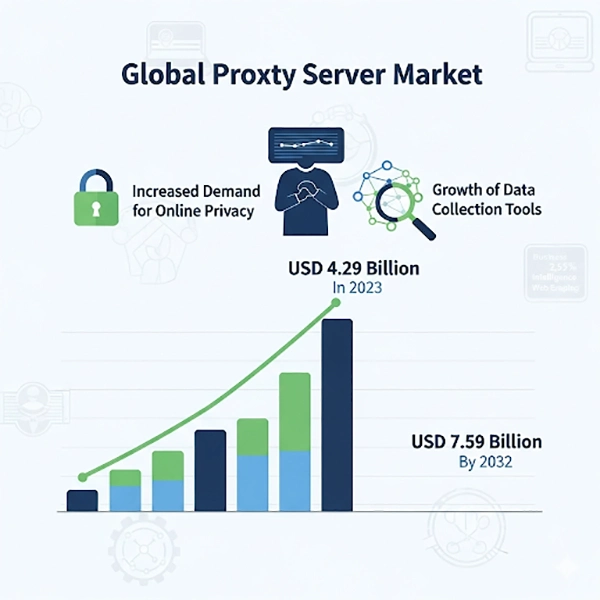As people have become more concerned with their digital footprints, the demand for some level of privacy has also grown considerably. According to the report, about six-in-ten Americans (63%) are concerned about online privacy. However, only 3% report that they understand how the laws related to protecting their privacy work to any level of detail.
The gap between the previous sentiment and the latter sentiment may show the knowledge of people obtaining tools for digital anonymity. The anonymous proxy as a primary and general privacy solution is now meeting developing demand.
Since many people are looking for a general solution to cope with these things in the digital era, they need proper knowledge first. Therefore, this guide specifically talks about anonymous proxies and the best options in 2025 to maintain digital privacy.
KEY TAKEAWAYS
- An anonymous proxy acts as a mask to hide its real IP address and network details.
- The best proxies are specifically designed for each use.
- The criteria for selection include a strong IP mask, IP pool quality, and size.
- Modern proxies offer advanced features like City-level geo-targeting, strong use of API automation, and clear logging for birthday
Target websites are unable to see your device’s actual address or network information because an anonymous proxy routes your traffic through a third-party IP. In 2025, the key components include strong IP masking (no X-Forwarded-For or Via leaks), encrypted transport, and protocol flexibility (HTTPS and SOCKS5).
Two big choices still shape performance and control: residential vs. datacenter IPs, and rotating vs. static sessions. Residential pools copy everyday consumer connections for higher trust, while datacenter IPs deliver speed and cost efficiency. Rotating sessions shifts IPs automatically per request or interval for scale, whereas static sessions preserve one IP for account-like consistency.
Modern services add session controls (sticky timers), city-level geotargeting, and dashboard/API tooling so teams can manage thousands of simultaneous connections. The “best” option won’t just hide you—it will help you stay consistent, compliant, and measurable.
Anonymous proxies stand out whenever your tasks demand neutral, location-accurate views or clean separation from your office network. Utilize them to minimize bias in testing, avoid rate-limit surprises, and collect data methodically without revealing internal infrastructure. Typical greater value scenarios include:
In each case, operate within site terms and applicable laws, and document internal instructions so your team uses proxies responsibly and consistently.
INTERESTING FACT
The global proxy server market, valued at approximately USD 4.29 billion in 2023, is projected to grow to around USD 7.59 billion by 2032, reflecting a significant increase in demand for online privacy and data collection tools.

Commence with anonymity and integrity. Verify the provider strips identifying headers and supports end-to-end encryption. After that, evaluate IP quality: size and freshness of the pool, country/city coverage, and success rates on your actual targets.
If your workflows require repeat logins or cart persistence, sticky sessions with configurable timeouts are essential.
Operational efficiency is your next gate. Look for low median latency, stable throughput, and automatic retries. Uptime guarantees and clear incident histories indicate a mature network. Then check for developer experience: dashboards that surface request logs and error codes, robust APIs and SDKs, and clear documentation for quick onboarding.
Don’t ignore policy and support? You want a provider with explicit acceptable-use and data-handling policies, in fact, responsive 24/7 support through chat or ticketing. At the end, pricing clarity matters: pay-as-you-go for bursts, predictable monthly bundles for teams, and sane overage rules. The “best” service provider will let you start small, prove value fast, and scale without friction.
| Criterion | Why it matters | What “best” looks like |
| Anonymity & header hygiene | Prevents IP leaks that expose origin | No X-Forwarded-For/Via; TLS everywhere |
| IP quality & coverage | Boosts success rates and accuracy | Large, fresh pools; city-level targeting |
| Session control | Enables logins and stable flows | Sticky timers, rotation rules, easy resets |
| Performance & reliability | Keeps automations fast and stable | Low latency, high success %, uptime SLA |
| Tooling & visibility | Shortens debugging time | Detailed logs, APIs/SDKs, metrics |
| Compliance & support | Reduces risk and downtime | Clear AUP, 24/7 human support, auditability |
Use this informative table as a pre-purchase scorecard: test on your real targets, record success rates, and rank providers across each dimension. Even a one-day pilot can reveal sensible differences in block rates and stability.
Treat your proxy layer as production infrastructure. Standardize request headers to ignore odd client fingerprints. Tune rotation frequency to match your workflow—high-churn scraping advantages from aggressive rotation, while account testing calls for longer stickiness.
Stagger concurrency to evict from sudden spikes, and implement back off on 429/5xx responses. Keep a living allowlist of target domains and reasons for access so compliance reviews are simple. At last, keep track of everything: success rate, latency, error taxonomies, and the distribution of response codes. If you’re all-set to scale, you can buy anonymous proxy access and run a proof-of-concept before committing long term.
“The best anonymous proxy 2025” isn’t about pursuing a single brand—it’s about finding a platform that fits your use case with strong success rates, verifiable anonymity, and dependable support.
Prioritize session control, IP quality, and tooling that makes your team faster. Operate a structured pilot, measure real outcomes, and select the provider that turns your proxy layer into a quiet, reliable utility. When the proxy vanishes into the background and your workflows just work—that’s when you know you chose well.
Residential proxies use IP addresses assigned by ISPs, while data centre proxies use IPS from a data centre to offer great speed and cost-efficiency.
Sticky sessions are necessary for tasks that require maintaining a single IP address for a consistent period.
VPN operates at a device level, routing all of your internet, whereas an anonymous proxy typically operates at the application level, fluidic traffic for specific applications.
Both are suitable and specified for their own task.
